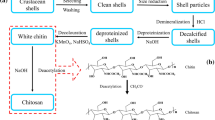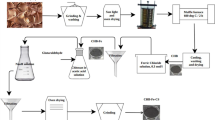Abstract
Novel polyelectrolyte complexes based on sulfated carboxymethyl cellulose and chitosan were prepared, containing strongly charged (sulfate (OSO3)) and weakly charged (carboxylate (COO−)) groups (SPECs). SPEC homogeneous membranes (SPECMs) for the pervaporation dehydration of ethanol–water mixtures were investigated. The chemical structures and compositions of SPECMs were characterized by Fourier transform infrared spectroscopy and X-ray photoelectron spectra. The swelling behavior and separation performance of SPECMs in low pH feed were evaluated. It was found that the SPECMs containing OSO3 groups were resistant to acidic feeds and showed very good separation performance even in low pH feed. For instance, the water content in permeate for SPECM-0.35 reached as high as 95.8 wt%, which was much higher than the 60 wt% for SPECM-0 in the dehydration of water–ethanol mixtures with pH 2. The result was attributed to the interplay between the stable complexation formed by OSO3 groups and the improved ionization degree of COO− groups in SPECMs. Moreover, the SPECMs maintained their operation stability against acidic feeds. The SPECMs could find considerable potential application in the pervaporation dehydration of acidic feeds, especially for enhancing the conversion of ester condensation.













Similar content being viewed by others
Abbreviations
- CMC:
-
Carboxymethyl cellulose
- CS:
-
Chitosan
- COO− :
-
Carboxylate groups
- COOH:
-
Carboxyl groups
- SCMC:
-
Sulfated carboxymethyl cellulose
- OSO3 :
-
Sulfate
- ESD:
-
Equilibrium swelling degree
- α :
-
Separation factor
- α s :
-
Sorption selectivity
- α d :
-
Diffusion selectivity
- J :
-
Total flux (g m−2 h)
- SCMC-X:
-
SCMC with X ratio of OSO3Na to COONa groups
- PECs:
-
Polyelectrolyte complexes
- SPECs:
-
PECs containing OSO3 groups
- SPEC-Y:
-
SPECs with Y molar percent OSO3 groups
- SPEC-0:
-
SPEC containing no OSO3 groups
- PECMs:
-
Polyelectrolyte complexes membranes
- SPECMs:
-
PECMs containing OSO3 groups
- SPECM-Y:
-
SPECM with Y molar percent OSO3 groups
- SPECM-0:
-
SPECM containing no OSO3 groups
References
Aarne N, Kontturi E, Laine J (2012) Carboxymethyl cellulose on a fiber substrate: the interactions with cationic polyelectrolytes. Cellulose 19:2217–2231
Bhat SD, Aminabhavi TM (2007) Pervaporation separation using sodium alginate and its modified membranes—a review. Sep Purif Rev 36:203–229
Bhat SD, Aminabhavi TM (2009) Pervaporation-aided dehydration and esterification of acetic acid with ethanol using 4A zeolite-filled cross-linked sodium alginate-mixed matrix membranes. J Appl Polym Sci 113:157–168
Bolto B, Tran T, Hoang M, Xie ZL (2009) Crosslinked poly(vinyl alcohol) membranes. Prog Polym Sci 34:969–981
Bolto B, Hoang M, Xie ZL (2011) A review of membrane selection for the dehydration of aqueous ethanol by pervaporation. Chem Eng Process 50:227–235
Budd PM, Ricardo NMPS, Jafar JJ, Stephenson B, Hughes R (2004) Zeolite/polyelectrolyte multilayer pervaporation membranes for enhanced reaction yield. Ind Eng Chem Res 43:1863–1867
Cai T, Yang Z, Li H, Yang H, Li A, Cheng R (2013) Effect of hydrolysis degree of hydrolyzed polyacrylamide grafted carboxymethyl cellulose on dye removal efficiency. Cellulose 20:2065–2614
Chapman PD, Oliveira T, Livingston AG, Li K (2008) Membranes for the dehydration of solvents by pervaporation. J Membr Sci 318:5–37
Choi J, Rubner MF (2005) Influence of the degree of ionization on weak polyelectrolyte multilayer assembly. Macromolecules 38:116–124
Chovau S, Gaykawad S, Straathof AJJ, Bruggen B (2011) Influence of fermentation by-products on the purification of ethanol from water. Bioresour Technol 102:1669–1674
Ding JW, Zhang MH, Jiang ZY, Li YF, Ma J, Zhao J (2012) Enhancing the permselectivity of pervaporation membrane by constructing the active layer through alternative self-assembly and spin-coating. J Membr Sci 390–391:218–225
Dubas ST, Schlenoff JB (2001a) Polyelectrolyte multilayers containing a weak polyacid: construction and deconstruction. Macromolecules 34:3736–3740
Dubas ST, Schlenoff JB (2001b) Swelling and smoothing of polyelectrolyte multi-layers by salt. Langmuir 17:7725–7727
Feng X, Huang RYM (1997) Liquid separation by membrane pervaporation: a review. Ind Eng Chem Res 36:1048–1066
Gebhardt JE, Furstenau DW (1983) Adsorption of polyacrylic acid at oxide/water interfaces. Colloids Surf 7:221–231
Gimenes ML, Liu L, Feng X (2007) Sericin/poly (vinyl alcohol) blend membranes for pervaporation separation of ethanol/water mixtures. J Membr Sci 295:71–79
Heinze T, Pfeiffer K (1999) Studies on the synthesis and characterization of carboxymethylcellulose. Angew Makromol Chem 266:37–45
Huang CH, Wang CF, Don TM, Chiu WY (2013) Preparation of pH- and thermo-sensitive chitosan PNIPAAm core-shell nanoparticles and evaluation as drug carriers. Cellulose 20:1791–1805
Jang Y, Akgum B, Kim H, Satija S, Char K (2012) Controlled release from model blend multilayer films containing mixtures of strong and weak polyelectrolytes. Macromolecules 45:3542–3549
Jiang LY, Wang Y, Chung TS, Qiao XY, Lai JY (2009) Polyimides membranes for pervaporation and biofuels separation. Prog Polym Sci 34:1135–1160
Jin HT, An QF, Zhao Q, Qian JW, Zhu MH (2010) Pervaporation dehydration of ethanol by using polyelectrolyte complex membranes based on poly (N-ethyl-4-vinylpyridinium bromide) and sodium carboxymethyl cellulose. J Membr Sci 347:183–192
Kim SG, Ahn HR, Lee KH (2009) Pervaporation characteristics of polyelectrolyte complex gel membranes based on anionic polysaccharides having a chelating structure. Curr Appl Phys 9:e42–e46
Krasemann L, Tieke B (2000) Highly efficient composite membranes for ethanol-water pervaporation. Chem Eng Technol 23:211–213
Liu YL, Hsu CY, Su YH, Lai JY (2005) Chitosan-silica complex membranes from sulfonic acid functionalized silica nanoparticles for pervaporation dehydration of ethanol–water solutions. Biomacromolecules 6:368–373
Ma J, Zhang M, Lu L, Yin X, Chen J, Jiang Z (2009) Intensifying esterification reaction between lactic acid and ethanol by pervaporation dehydration using chitosan–TEOS hybrid membranes. Chem Eng J 155:800–809
Magalad VT, Gokavi GS, Nadagouda MN, Aminabhavi TM (2011) Pervaporation separation of water ethanol mixtures using organic–inorganic nanocomposite membranes. J Phys Chem C 115:14731–14744
Magalad VT, Gokavi GS, Ranganathaiah C, Burshe MH, Han C, Dionysiou DD, Nadagouda MN, Aminabhavi TM (2013) Polymeric blend nanocomposite membranes for ethanol dehydration—effect of morphology and membrane–solvent interactions. J Membr Sci 430:321–329
Moo YD, Oh BK, Lee YM (1992) Preparation of water-acetic through polyimide membranes form 3,3′,4,4′-benzophenone teracarboxylic dianhydride and 4,4′-oxydianiline. Polym Bull 29:431–438
Nagase T, Kiyozumi Y, Hasegawa Y, Inoue T, Inoue T, Ikeda T, Mizukami F (2007) Dehydration of concentrated acetic acid solutions by pervaporation using novel MER zeolite membranes. Chem Lett 36:594–595
Nam SY, Lee YM (1997) Pervaporation and properties of chitosan–poly (acrylic acid) complex membranes. J Membr Sci 135:161–171
Scharnagl N, Peinemann KV, Wenzlaff A, Schwarz HH, Behling RD (1996) Dehydration of organic compounds with SYMPLEX composite membranes. J Membr Sci 113:1–5
Schwarz HH, Lukáš J, Richau K (2003) Surface and permeability properties of membranes from polyelectrolyte complexes and polyelectrolyte surfactant complexes. J Membr Sci 218:1–9
Shao P, Huang RYM (2007) Polymeric membrane pervaporation. J Membr Sci 287:162–179
Shi GM, Chen H, Jean YC, Chung TS (2013) Sorption, swelling, and free volume of polybenzimidazole (PBI) and PBI/zeolitic imidazolate framework (ZIF-8) nano-composite membranes for pervaporation. Polymer 54:774–783
Shih CM, Shieh YT, Twu YK (2009) Preparation and characterization of cellulose/chitosan blend films. Carbohydr Polym 78:169–174
Suhas DP, Raghu AV, Jeong HM, Aminabhavi TM (2013) Graphene-loaded sodium alginate nanocomposite membranes with enhanced isopropanol dehydration performance via a pervaporation technique. RSC Adv 3:17120–17130
Sui ZJ, Jaber J, Schlenoff JB (2006) Polyelectrolyte complexes with pH-tunable solubility. Macromolecules 39:81450–88152
Sukhishvili SA, Kharlampieva E, Izumrudov V (2006) Where polyelectrolyte multilayers and polyelectrolyte complexes meet. Macromolecules 39:8873–8881
Thünemann AF, Müller M, Dautzenberg H, Joanny JF, Löwen H (2004) Polyelectrolyte complexes. Adv Polym Sci 166:113–171
Tjipto E, Quinn JF, Caruso F (2005) Assembly of multilayer film from polyelectrolytes containing weak and strong acid moieties. Langmuir 21:8785–8792
Uragami T, Tuskamoto K, Miyata T, Heinze T (1999) Permeation and separation characteristics for benzene/cyclohexane mixtures through tosylcellulose membranes in pervaporation. Cellulose 6:221–231
Uragami T, Ohshima T, Miyata T (2003) Removal of benzene from an aqueous solution of dilute benzene by various crosslinked poly (dimethylsiloxane) membranes during pervaporation. Macromolecules 36:9430–9436
Veerapur RS, Gudasi KB, Patil MB, Babu VR, Bhat SD, Sairam M, Aminabhavi TM (2006) Sodium alginate–poly(hydroxyethylmethacrylate) interpenetrating polymeric network membranes for the pervaporation dehydration of ethanol and tetrahydrofuran. J Appl Polym Sci 101:3324–3329
Vogt S, Klemm D, Heinze T (1996) Effective esterification of carboxymethyl cellulose in a new non-aqueous swelling system. Polym Bull 36:549–555
Wang XS, An QF, Zhao Q, Lee KR, Qian JW, Gao CJ (2012) Preparation and pervaporation characteristics of novel polyelectrolyte complex membranes containing dual anionic groups. J Membr Sci 415–416:145–152
Wang XS, An QF, Zhao Q, Lee KR, Qian JW, Gao CJ (2013) Homogenous polyelectrolyte complex membranes incorporated with strong ion-pairs with high pervaporation performance for dehydration of ethanol. J Membr Sci 435:71–79
Xu GF, Zhu WP (2011) Pervaporation for separating benzene/cyclohexane mixture by P (AA-MA) copolymer membranes. Chin J Polym Sci 292:88–295
Yang G, Zhang L, Peng T, Zhong W (2000) Effects of Ca2+ bridge crosslinking on structure and pervaporation of cellulose/alginate blend membranes. J Membr Sci 175:53–60
You J, Hu H, Zhou J (2013) Synthesis, structure and solution properties of the novel polyampholytes based on cellulose. Cellullose 20:1175–1185
Zhang G, Ruan Z, Ji S, Liu Z (2010) Construction of metal–ligand-coordinated multilayers and their selective separation behavior. Langmuir 26:4782–4789
Zhang QG, Hu WW, Zhu AM, Liu QL (2013) UV-crosslinked chitosan/polyvinylpyrrolidone blend membranes for pervaporation. RSC Adv 3:1855–1861
Zhao Q, An QF, Sun ZW, Qian JW, Lee KL, Gao CJ, Lai JY (2010) Studies on structures and ultrahigh permeability of novel polyelectrolyte complex membranes. J Phys Chem B 114:8100–8106
Zhao Q, An QF, Ji YL, Qian JW, Gao CJ (2011) Polyelectrolyte complex membranes for pervaporation, nanofiltration and fuel cell applications. J Membr Sci 379:19–45
Zhu Z, Feng X, Penlidis A (2007) Layer-by-layer self-assembled polyelectrolyte membranes for solvent dehydration by pervaporation. Mater Sci Eng C 27:612–619
Acknowledgments
This research was financially supported by the NNSFC (51173160, 21376206), the Fundamental Research Funds for the Central Universities (no. 2013QNA4049) and the National Basic Research Program of China (No. 2009CB623402).
Author information
Authors and Affiliations
Corresponding author
Electronic supplementary material
Below is the link to the electronic supplementary material.
Rights and permissions
About this article
Cite this article
Wang, XS., An, QF., Zhao, FY. et al. Preparation and separation characteristics of polyelectrolyte complex membranes containing sulfated carboxymethyl cellulose for water–ethanol mixtures at low pH. Cellulose 21, 3597–3611 (2014). https://doi.org/10.1007/s10570-014-0336-x
Received:
Accepted:
Published:
Issue Date:
DOI: https://doi.org/10.1007/s10570-014-0336-x




